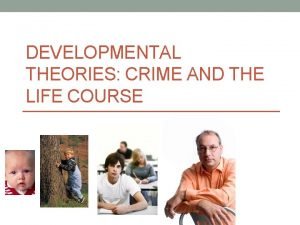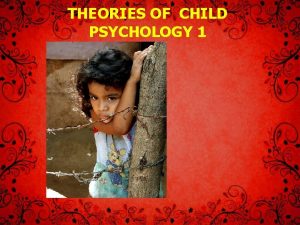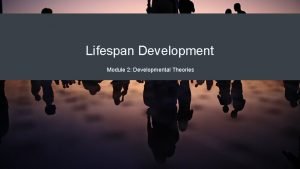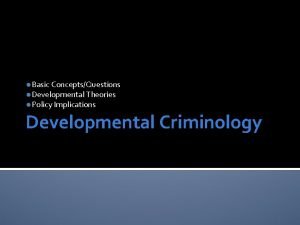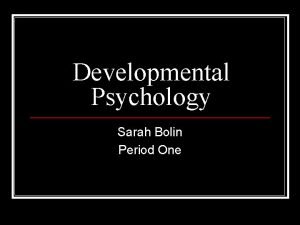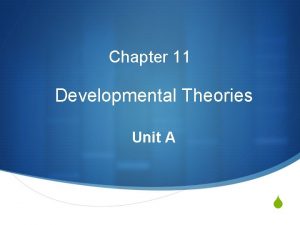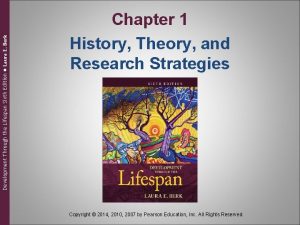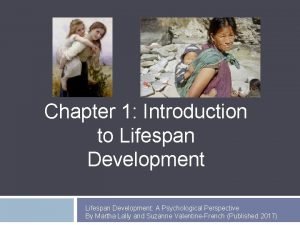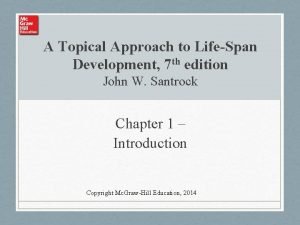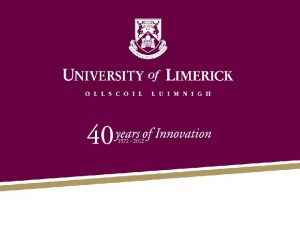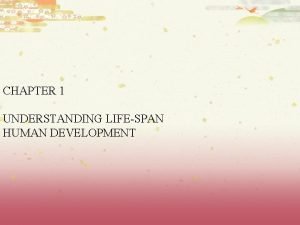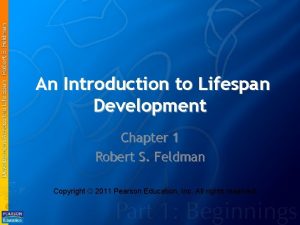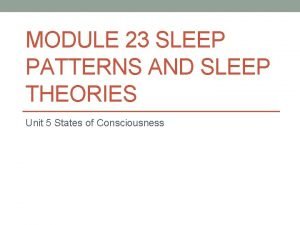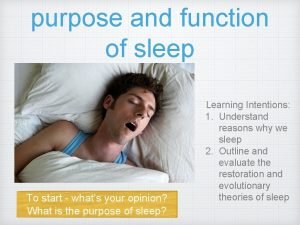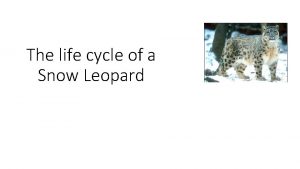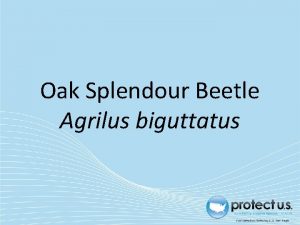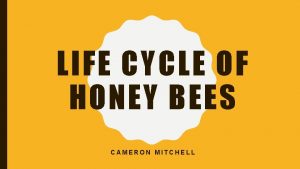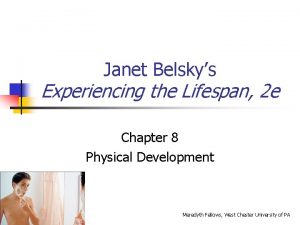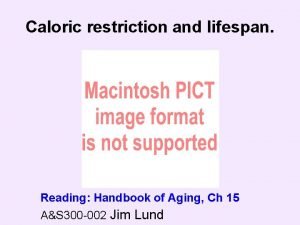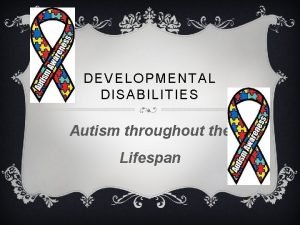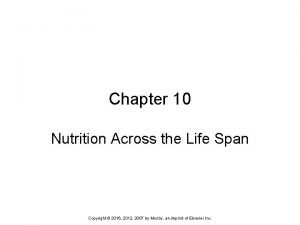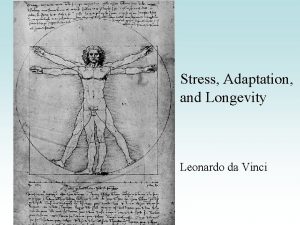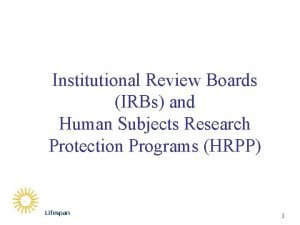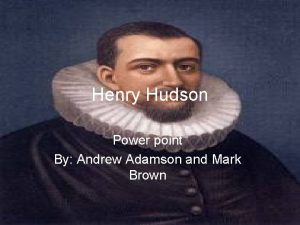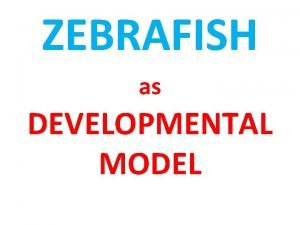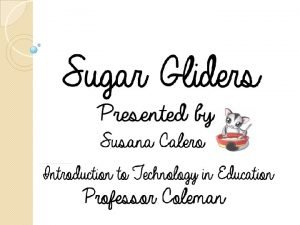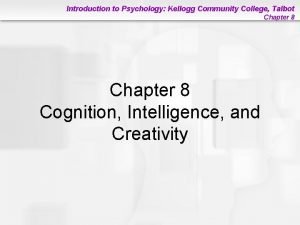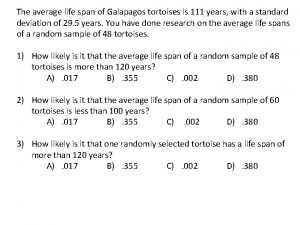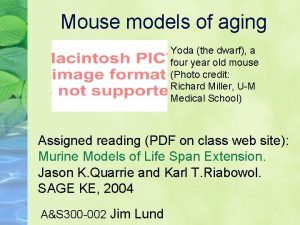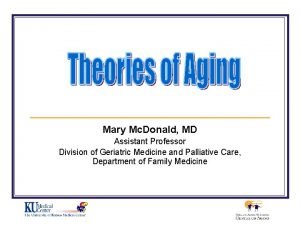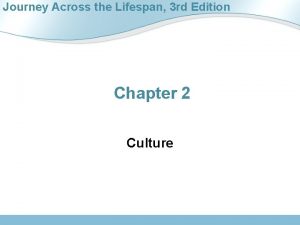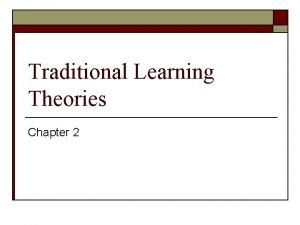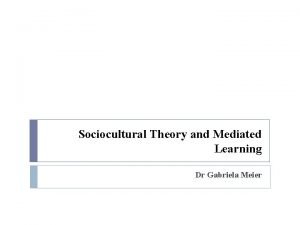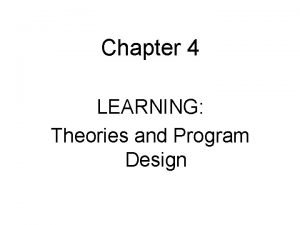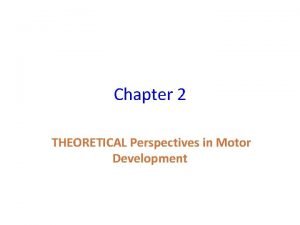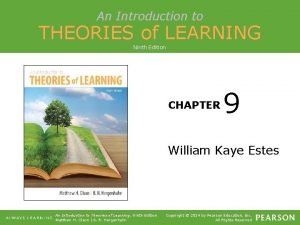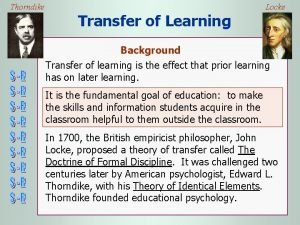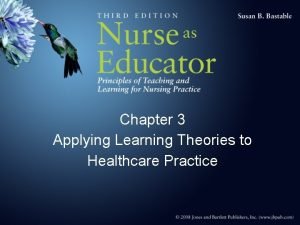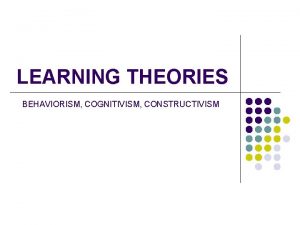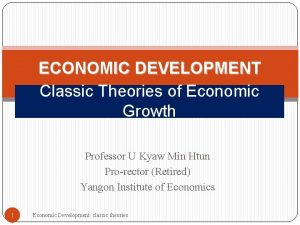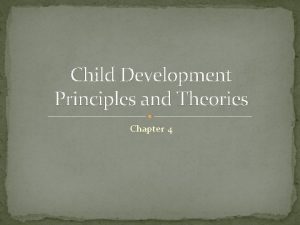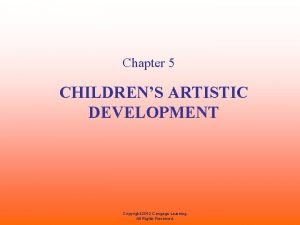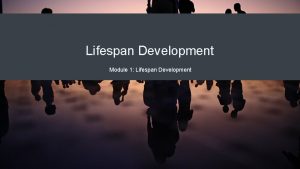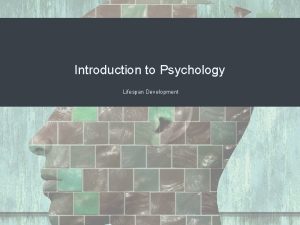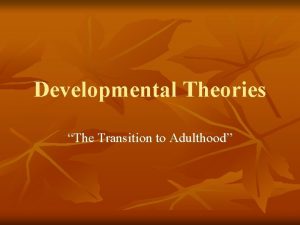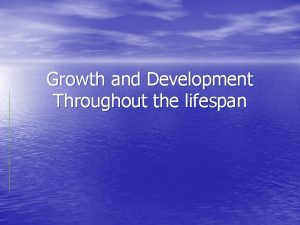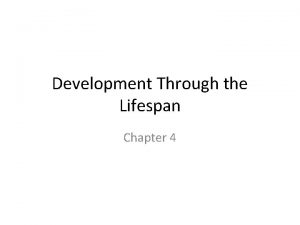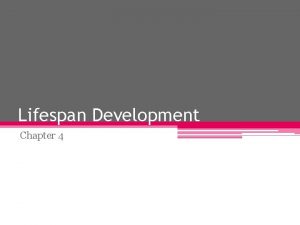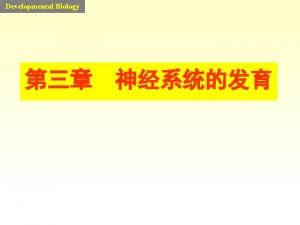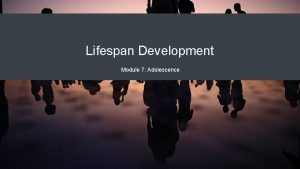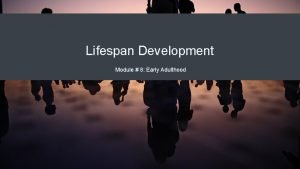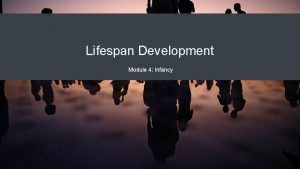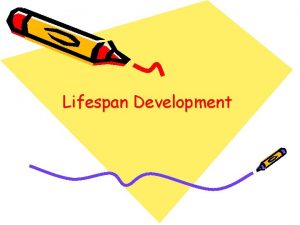Lifespan Development Module 2 Developmental Theories Module Learning

































































- Slides: 65

Lifespan Development Module 2: Developmental Theories

Module Learning Outcomes Describe the major developmental theories in lifespan development 2. 1: Use psychodynamic theories (like those from Freud and Erikson) to explain development 2. 2: Explain key principles of behaviorism and cognitive psychology 2. 3: Describe the humanistic, contextual, and evolutionary perspectives of development

Psychodynamic Theories

Learning Outcomes: Psychodynamic Theories 2. 1: Use Psychodynamic Theories to Explain Development 2. 1. 1: Describe theories as they relate to lifespan development 2. 1. 2: Describe the historical foundations leading to the development of theories about lifespan development 2. 1. 3: Describe Freud's theory of psychosexual development 2. 1. 4: Describe Erikson's eight stages of psychosocial development

Key Concepts in the Scientific Approach • Theory: a well-developed set of ideas that propose an explanation for behavior and events that is used to make predictions about future observations • Hypothesis: a testable prediction that is arrived at logically from a theory, often worded as an if-then statement

Areas of Disagreement among Theorists • Three key issues remain among which developmental theorists often disagree • Passive versus active: the role of early experiences on later development versus current behavior reflecting present experiences • Continuity versus discontinuity: whether or not development is best viewed as occurring in stages or as a gradual and cumulative process of change • The nature/nurture debate: the role of heredity and the environment in shaping human development

History of Developmental Psychology • The scientific study of children began in the late nineteenth century, and blossomed in the early twentieth century • Three early scholars: • John Locke: proposed that the mind of the newborn as a tabula rasa (“blank slate”) on which knowledge is written through experience and learning • Jean-Jacques Rousseau: proposed that development occurs according to innate processes and progresses through three stages: infancy, childhood, and adolescence • Charles Darwin: known for his theory of evolution

Early Scholars in Developmental Psychology • G. Stanley Hall: established scientific journals for publishing child development research, first president of the American Psychological Association • James Mark Baldwin: conducted quantitative and experimental research on infant development • John B. Watson: founder of the field of behaviorism • Sigmund Freud: psychoanalytic approach and model of psychosexual development • Arnold Gesell: conducted the first large-scale study of children’s behavior that revealed consistent patterns of development focused on biological “maturation” • Jean Piaget: stage theory of cognitive development

Freud’s Psychodynamic Perspective • Dominated the field of psychiatry until the growth of behaviorism in the 1930 s • Proposed that personality forms during the first few years of life • Proposed that the ways in which parents or other caregivers interact with children have a long-lasting impact on children’s emotions, behavior, and personality • Suggested the first purely psychological explanation for physical problems and mental illness • Proposed that unconscious motives, desires, fears, and anxieties drive our actions

Freud’s Theory of Personality ● Three parts to adult personality: ○ Id: includes our instincts and drives, wants immediate gratification, the pleasure principle (something is judged good or bad depending on whether it feels good or bad) ○ Ego: develops during the first three years of life, the rational part of our personality, the reality principle (helps the id satisfy its desires in a realistic way), considered the self ○ Superego: emerges around age five, rulebased, acts as our conscience ● A strong ego to balance the id and superego -> healthy personality ● Imbalances -> neurosis or a tendency to experience negative emotions

Freud’s Theory of Psychosexual Development • If we do not have the proper nurturing and parenting during a stage, we will be stuck, or fixated, in that stage, even as adults • In each stage, the child’s pleasure-seeking urges, coming from the id, are focused on a different area of the body, called an erogenous zone Stage Age (years) Erogenous Zones Major Conflict Adult Fixation Example Oral 0 to 1 Mouth Weaning off breasts or bottle Smoking, over eating Anal 1 to 3 Anus Toilet training Neatness, messiness Phallic 3 to 6 Genitals Oedipus/Electra Complex Vanity, overambition Latency 6 to 12 None General 12 and older Genitals None

Stages of Psychosexual Development • Oral Stage • Infant meets needs for comfort, warmth, food, and stimulation primarily through immediate oral gratification • Psychologically, the infant is all id • If the caregiver meets oral needs consistently, the child will move away from this stage and progress further • Inconsistent or neglectful caregiving can lead to the child becoming fixated in the oral stage and as an adult this person may engage in eating, drinking, smoking, nail-biting, or compulsive talking to feel comfort when afraid or insecure

Stages of Psychosexual Development (cont. I) • Anal Stage • The ego is being developed • Associated with toddlerhood and potty-training • The child is learning self-control and taught that some urges must be contained and some actions postponed • Fixation at this stage • Anal retentive (fear of letting go) as a result of overly controlling caregiving; the person might be extremely neat and clean, organized, reliable, and controlling of others • Anal expulsive as a result of the caregiver neglecting to teach the child to control urges; the person might become an adult who is messy, irresponsible, and disorganized

Stages of Psychosexual Development (cont. II) • Phallic Stage • preschool years (ages 3 -5) • Oedipus complex: refers to a child’s unconscious sexual desire for the opposite-sex parent and hatred for the same-sex parent • Castration anxiety: Freud believed that the boy fears that if he pursues his mother, his father may castrate him • Electra complex: refers to a girl’s unconscious attraction for her father, followed by realizing she cannot compete with her mother, so she gives up that affection and learns to be more like her mother • Penis envy: Freud believed that the girl feels inferior because she does not have a penis • The formation of the superego occurs during the dissolution of the Oedipus and Electra complexes

Stages of Psychosexual Development (cont. III) • Latency Stage • Associated with middle childhood (6 -11) • Attention focused on family and friendships, the biological drives are temporarily quieted (latent) • If the child is able to make friends, they will gain a sense of confidence • If not, the child may continue to be a loner or shy away from others, even as an adult

Stages of Psychosexual Development (cont. IV) Genital Stage • Associated with adolescence throughout adulthood • A person is preoccupied with sex and reproduction • The adolescent experiences rising hormone levels and the sex drive and hunger drives become very strong • Ideally, according to Freud, the ego is strengthened during this stage and the adolescent uses reason to manage urges

Practice Question 1 According to Sigmund Freud’s theory, a person’s problematic behavior is based on _______. A. being stuck in the developmental task of trust vs. mistrust B. unconscious motives, fears, and anxieties C. observational learning without consequences D. a classically conditioned response

Practice Question 2 According to Sigmund Freud’s theory, an infant smiles because something feels good and cries because something feels bad because of the _______. A. Oedipus complex B. Electra complex C. reality principle D. pleasure principle

Defense Mechanisms • • Denial: not accepting the truth or lying to oneself Displacement: taking out frustrations on a safer target Projection: attributing unacceptable thoughts to others Rationalization: involves a cognitive distortion of “the facts” to make an event or an impulse less threatening Reaction formation: outwardly opposing something you inwardly desire, but that you find unacceptable Regression: going back to a time when the world felt like a safer place, perhaps reverting to one’s childhood behaviors Repression: pushing painful thoughts out of consciousness (in other words, thinking about something else) Sublimation: transforming unacceptable urges into more socially acceptable behaviors

Class Activity: Defense Mechanisms in Everyday Life 1. Get into groups of 3 or 4 2. Identify and share examples of defense mechanisms you observe being used in everyday life. These examples could come from TV shows, movies, or your own experience 3. Identify the purpose that the identified defense mechanisms serve 4. Identify how the use of the defense mechanisms might contribute to more problems (e. g. , in thinking, feeling, and relationships)

Assessing the Psychodynamic Perspective • During Freud’s era in Vienna at the turn of the 20 th century, there was a climate of sexual repression, combined with limited understanding and education surrounding human sexuality, which heavily influenced Freud’s perspective • Criticisms: • Very difficult to test scientifically • Freud’s theory is considered to be sexist • Freud suggested that much of what determines our actions is unknown to us (or unconscious) • Despite the criticisms, Freud’s assumptions about the importance of early childhood experiences in shaping our psychological selves have found their way into child development, education, and parenting practices

Erikson’s Psychosocial Theory • Erikson, as a student of Freud’s, expanded Freud’s theory of psychosexual development by emphasizing the importance of culture in parenting practices and motivations and adding three stages of adult development • Contrasts with Freud: • Erikson proposed that an individual’s personality develops throughout the lifespan, which is a departure from Freud’s view that personality is fixed in early life • Erikson emphasized the social relationships that are important at each stage of personality development, in contrast to Freud’s emphasis on erogenous zones • Erikson identified eight stages, each of which includes a conflict or developmental task. • The development of a healthy personality and a sense of competence depend on the successful completion of each task

Psychosocial Stages of Development Major psychosocial tasks to accomplish or crises to overcome (with defining virtues in parentheses) • Trust vs. Mistrust (Hope): From birth to 12 months of age, infants must learn that adults can be trusted • Autonomy vs. Shame (Will): Toddlers (ages 1– 3 years) explore their world and learn that they can control their actions and act on their environment to get results • Initiative vs. Guilt (Purpose): Preschoolers (ages 3– 6 years) are capable of initiating activities and asserting control over their world through social interactions and play • Industry vs. Inferiority (Competence): Elementary school children (ages 7– 12) either develop a sense of pride and accomplishment in their schoolwork, sports, social activities, and family life, or they feel inferior and inadequate because they believe they do not measure up

Psychosocial Stages of Development (cont. ) Major psychosocial tasks to accomplish or crises to overcome (with defining virtues in parentheses) • Identity vs. Role Confusion (Fidelity): Adolescents’ (ages 12– 18) main task is developing a sense of self; they explore various roles and ideas, set goals, and attempt to discover their adult selves • Intimacy vs. Isolation (Love): People in early adulthood (20 s through early 40 s) are concerned with developing and maintaining successful relationships with others • Generativity vs. Stagnation (Care): People in middle adulthood (40 s to the mid-60 s) are concerned with finding their life’s work and contributing to the development of others • Integrity vs. Despair (Wisdom): People in late adulthood (mid-60 s to the end of life) are concerned with reflecting on their lives and feeling either a sense of pride and satisfaction or a sense of regret and failure

Assessing Erikson’s Theory • Strength • View that development continues throughout the lifespan • Weaknesses • Stages or crises can occur more than once or at different times of life • Focuses heavily on stages and assumes that the completion of one stage is a prerequisite for the next stage of development • Focuses on the social expectations that are found in certain cultures, but not in all • Focuses on more men than women • Difficult to test rigorously because of its vagueness

Practice Question 3 According to Erikson’s theory, children either develop a sense of competence, pride, and accomplishment or a sense of inadequacy during which stage of psychosocial development? A. Autonomy versus Shame B. Initiative versus Guilt C. Industry versus Inferiority D. Identity versus Role Confusion

Behaviorism and Cognitive Psychology

Learning Outcomes: Behaviorism and Cognitive Psychology 2. 2: Explain key principles of behaviorism and cognitive psychology 2. 2. 1: Describe the principles of classical conditioning 2. 2. 2: Describe the principles of operant conditioning 2. 2. 3: Describe social learning theory 2. 2. 4: Describe Piaget's theory of cognitive development 2. 2. 5: Describe information processing approaches to cognitive development

The Behavioral Perspective • Behaviorism emerged early in the 20 th century • The keys to understanding development are observable behavior and external stimuli in the environment • Behaviorism refers to theories of learning that focus on how we respond to events or stimuli rather than emphasizing internal factors (e. g. , mind or consciousness) that motivate our actions • Through the scientific study of behavior, it was hoped that laws of learning could be derived that would promote the prediction and control of behavior

Classical Conditioning ● Associated with Ivan Pavlov, a Russian physiologist studying digestion ● Classical conditioning helps us understand how our responses to one situation become attached or connected to new situations ● Classical conditioning explains how we develop many of our emotional responses to people or events or our “gut level” reactions to situations

Pavlov’s Classical Conditioning Experiments Before Conditioning: Unconditioned stimulus (food) produces an unconditioned response (salivation) During Conditioning: Neutral stimulus (bell) is presented just before the unconditioned stimulus (food) After Conditioning: the neutral stimulus becomes a conditioned stimulus (bell) when presented alone and now produces a conditioned response (salivation)

Watson and Behaviorism • Established the psychological school of behaviorism • Known for applying classical conditioning principles to human behavior • Believed that most of our fears and other emotional responses are classically conditioned • Believed that parents could be taught to help shape their children’s behavior • Tried to demonstrate the power of classical conditioning with his famous experiment with an 18 -month-old boy named “Little Albert, ” who he conditioned to fear a white rat (which the child did not initially fear)

Operant Conditioning ● Associated with B. F. Skinner, who sought to explain how new behaviors are learned, not just how existing behaviors are reflexively elicited (as in classical conditioning) ● Behavior is motivated by the consequences we receive for the behavior: the reinforcements and punishments ● In operant conditioning, we learn to associate a behavior and its consequence; behaviors are either strengthened or weakened because of their consequences

The Law of Effect • Skinner based his ideas on the law of effect, first proposed by psychologist Edward Thorndike • Behaviors followed by consequences that are satisfying are more likely to be repeated • Behaviors followed by unpleasant consequences are less likely to be repeated • Skinner believed that we learn best when our actions are reinforced • A reinforcer is anything following a behavior that makes it more likely to occur again I • Intrinsic or primary reinforcers (e. g. , food or praise) • Secondary reinforcers (e. g. , money, which can be exchanged for what one really wants)

The Skinner Box • Skinner conducted scientific experiments on animals (mainly rats and pigeons) to determine how organisms learn through operant conditioning • He placed the animals inside an operant conditioning chamber, also known as a “Skinner box” • A Skinner box contains a lever (for rats) or disk (for pigeons) that the animal can press or peck for a food reward via the dispenser

Social Cognitive Theory • Associated with Albert Bandura • Originally known as Social Learning Theory, developed in the 1960 s • Proposes that learning occurs in a social context through a dynamic and reciprocal interaction of the person, their own behavior, and the environment • Reciprocal determinism: the interplay between our personality and the way we interpret events and how they influence us • Observational learning: individuals can learn novel responses by watching the key behavior of others, referred to as social models • Social models are typically of higher status or authority compared to the observer, such as parents and teachers

Observational Learning Process • The observational learning process consists of four parts • Attention: one must pay attention to what they are observing in order to learn • Retention: to learn one must be able to retain the behavior they are observing in memory • Initiation: the learner must be able to execute (or initiate) the learned behavior • Motivation: needed to engage in observational learning • Consequences can play a role in observational learning • Vicarious reinforcement occurs when people’s behavior is influenced by observing social models receive reinforcement or punishment

Practice Question 4 Which form of learning occurs when a voluntary response is strengthened or weakened by its association with positive or negative consequences that occur soon after the response? A. B. C. D. Classical conditioning Operant conditioning Observational learning Psychosocial learning

Practice Question 5 Which behavioral theory proposes that we learn new responses by observing others model the behavior? A. B. C. D. Social Cognitive Theory Operant conditioning Classical Conditioning Psychosocial Theory

The Cognitive Perspective • Cognitive theories focus on how our mental processes or cognitions change over time • Jean Piaget developed theory of cognitive development (a stage theory) as a comprehensive theory about the nature and development of human intelligence • Making sense of the world • When faced with something new, a child may either fit it into an existing framework (schema) and match it with something known (assimilation) or expand the schema to accommodate the new situation (accommodation) by learning new words and concepts • The underlying dynamic of cognition: determine whether new information fits into our old way of thinking or whether we need to modify our thoughts

Piaget’s Stages of Cognitive Development: Sensorimotor A series of four stages approximately associated with age ranges 1. Sensorimotor (from birth to about 2 years old) • Children learn through their senses and motor behavior • Object permanence: the understanding that even if something is out of sight, it still exists, develops between 5 and 8 months old • Stranger anxiety: a fear of unfamiliar people

Piaget’s Stages of Cognitive Development: Preoperational A series of four stages approximately associated with age ranges 2. Preoperational (from about 2 to 7 years old) • Children can use symbols to represent words, images, and ideas and engage in pretend play • Children begin to use language, but they cannot understand adult logic or mentally manipulate information • Preoperational children have not developed conservation: even if you change the appearance of something, it is still equal in size as long as nothing has been removed or added • Egocentrism: the child is not able to take the perspective of others • Theory-of-mind: understanding that people have thoughts, feelings, and beliefs that are different from one’s own, usually develops between 3 to 5 years old

Piaget’s Stages of Cognitive Development: Concrete Operational A series of four stages approximately associated with age ranges 3. Concrete Operational (from about 7 to 11 years old) • Children can think logically about real (concrete) events • They have a firm grasp on the use of numbers and start to employ memory strategies • Children also master the concept of conservation and understand that even if something changes shape, its mass, volume, and number stay the same • Children understand the principle of reversibility: objects can be changed and then returned back to their original form or condition

Piaget’s Stages of Cognitive Development: Formal Operational A series of four stages approximately associated with age ranges 4. Formal Operational (from about age 11 to adulthood) • Children can deal with abstract ideas and hypothetical situations • Children can use abstract thinking to problem solve, look at alternative solutions, and test these solutions • A renewed egocentrism occurs in adolescence

Piaget’s Stages of Cognitive Development Criticisms • Newer research supports a model of development that is more continuous than Piaget’s discrete stages • Other research suggests that children reach cognitive milestones earlier than Piaget describes • Across cultures, there is considerable variation in what children are able to do at various ages, and Piaget may have underestimated what children are capable of given the right circumstances • Many developmental psychologists suggest a fifth stage of cognitive development, known as the postformal stage wherein decisions are made based on circumstances, and logic is integrated with emotion as adults develop principles that depend on contexts • Postformal thinkers are able to draw on past experiences to help them solve new problems

Information Processing Approaches to Development • Considered an alternative to Piagetian approaches • Emphasizes a continuous pattern of development • We do not just respond to stimuli, we process the information we receive • The model assumes that complex behavior can be broken down into a series of specific steps, and as we develop strategies for processing information, we can learn more complex information • Standard information-processing model includes: • Attention mechanisms for bringing information in • Working memory for actively manipulating information • Long-term memory for passively holding information so that it can be used in the future

Neo-Piagetian Theories • View cognition as a made up of different types of individual skills, rather • • than a single system of increasingly sophisticated general cognitive abilities Use the same terminology as information processing approaches Cognitive development proceeds quickly in certain areas and more slowly in others Experience plays a greater role in furthering cognitive development than traditional Piagetian approaches claim Adopted principles from other theories, such as social-cognitive theory, that allow them to consider how culture and interactions with others influenced cognitive development

Cognitive Neuroscience Approaches • Cognitive neuroscience: the scientific field that studies the biological processes that underlie cognition, with a specific focus on the neural connections and activity in the brain that are involved in mental processes (e. g. , problem solving) • Cognitive neuroscientists seek to identify actual locations and functions within the brain that are related to different types of cognitive activities • Developmental cognitive neuroscience: examines interrelations between brain changes and changes in cognitive ability as children grow up, as well as environmental and biological influences on the developing mind and brain

Practice Question 6 _______ is the understanding that even if something is out of sight, it still exists. A. B. C. D. Conservation Object permanence Reversibility Theory-of-mind

Humanistic, Contextual, and Evolutionary Perspectives

Learning Outcomes: Humanistic, Contextual, and Evolutionary Perspectives 2. 3: Describe the humanistic, contextual, and evolutionary perspectives of development 2. 3. 1: Describe the major concepts of humanistic theory as developed by Carl Rogers 2. 3. 2: Explain Maslow's hierarchy of needs 2. 3. 3: Describe Vygotsky's sociocultural theory of cognitive development 2. 3. 4: Explain Bronfenbrenner’s ecological systems model 2. 3. 5: Describe the evolutionary perspective 2. 3. 6: Contrast the main psychological theories that apply to human development

Carl Rogers and Humanism • Rogers’ emphasized the importance of the self-actualizing tendency in shaping personality • Humans are constantly reacting to stimuli with their subjective reality (phenomenal field), which changes continuously • Over time, a person develops a self-concept (i. e. , our thoughts and feelings about ourselves) based on feedback from this field of reality • Ideal self: the person that you would like to be • Real self: the person you actually are

Carl Rogers and Humanism (cont. ) • Human beings develop an ideal self and a real self based on the conditional status of positive regard • Congruity: how closely one’s real self matches up with the ideal self • Our self-concept is accurate when we experience congruence • High congruence leads to a greater sense of self-worth and a healthy, productive life • Incongruence: when there is a great discrepancy between our ideal and actual selves, which leads to maladjustment • According to Rogers, parents can help their children achieve their ideal self by giving them unconditional positive regard or unconditional love in an environment that is free of preconceived notions of value and worth

Carl Rogers and The Good Life Rogers described life in terms of principles rather than stages of development The good life: when a fully functioning person continually aims to fulfill his or her potential and demonstrate the following traits/tendencies: • • Openness to experience Existential lifestyle: living each moment fully Trusting one’s own judgment Freedom of choice High levels of creativity Reliability and constructiveness A rich full life: experiencing joy and pain, love and heartbreak, fear and courage more intensely

Maslow’s Hierarchy of Needs • Abraham Maslow: an American psychologist best known for proposing that a hierarchy of human needs motivates behavior • The most basic needs must be met before people become motivated to achieve higher level needs • The goal in Maslow’s theory is to attain self-actualization

Vygotsky’s Sociocultural Theory: A Contextual Perspective • Contextual perspective: considers the relationships between individuals and the physical, cognitive, personality, social, cultural, and environmental influences on development • Vygotsky believed that social interaction plays a critical role in children’s learning

Vygotsky’s Sociocultural Theory: A Contextual Perspective (cont. ) Three themes in Vygotsky’s ideas of sociocultural learning: 1. Human development and learning originate in social, historical, and cultural interactions • Guided participation: a learner actively acquires new culturally valuable skills and capabilities through a meaningful, collaborative activity with an assisting, more experienced person • Scaffolding: teachers model or demonstrate how to solve a problem, and then step back, offering support as needed 2. Use of psychological tools, particularly language, mediate development of higher mental functions 3. Learning occurs within the Zone of Proximal Development, the difference between what a learner can do without help and what they cannot do

Bronfenbrenner’s Ecological Systems Theory • Bronfenbrenner’s Ecological Systems Theory: the qualities of a child and their environment interact to influence how they will grow and develop • Ecological = a natural environment • Stresses the importance of studying a child in the context of multiple environments • Renamed theory the bioecological model to recognize the importance of biological processes in development • Chronosystem: the relevant historical context and timeframe in which all development occurs

The Evolutionary Perspective • The evolutionary perspective seeks to identify behavior that is the result of our genetic inheritance from our ancestors • Evolutionary psychology: a theoretical approach in the social and natural sciences that examines psychological structure from a modern evolutionary perspective • It seeks to identify which human psychological traits are evolved adaptations or the functional products of natural selection or sexual selection in human evolution • Evolutionary approaches claim that genetic inheritance not only determines physical traits such as skin and eye color, but also certain personality traits and social behaviors

Behavioral Genetics • Behavioral genetics: a field of scientific research that uses genetic methods to investigate the nature and origins of individual differences in behavior and studies the effects of heredity on behavior • Behavioral geneticists strive to understand how we might inherit certain behavioral traits and how the environment influences whether we actually display those traits • It also considers how genetic factors may influence psychological disorders such as schizophrenia, depression, and substance abuse

Evaluating Lifespan Theories • Developmental theories provide a set of guiding principles and concepts that describe and explain human development • Theories are based on their own premises and focus on different aspects of development (e. g. , a particular ability or development across the lifespan) • Many lifespan developmentalists use an eclectic approach, drawing on several perspectives simultaneously since the same developmental phenomenon can be viewed from a number of perspectives

Practice Question 7 According to Vygotsky, this gap between what a student can and cannot do without help is referred to as _______. A. B. C. D. the zone of proximal development theory of mind guided participation scaffolding

Practice Question 8 Which theory stresses the importance of studying a child in the context of multiple environments? A. B. C. D. Maslow’s Hierarchy of Needs Vygotsky’s Sociocultural Theory Bronfenbrenner’s ecological systems model Rogers’ humanistic theory

Class Activity: Ecological Systems in Real Life 1. Get into groups of 3 or 4 2. Select a biographical movie (e. g. , The Social Network, Hidden Figures, Frida) or autobiography and describe the influences on the main character’s development according to Bronfenbrenner’s Ecological Systems Model 3. Consider the following: • Microsystem: parents and siblings with direct, significant impact • Mesosystem: schools, extended family, religion • Exosystem: community values, history, economy • Macrosystem: cultural elements, global economic conditions, war, technology trends • Chronosystem: larger historical context and timeframe 4. Share your summary with the class

Quick Review What are the historical foundations of lifespan development theories? What is Freud’s theory of personality, including the three parts of adult personality? What is Freud’s theory of psychosexual development? What are defense mechanisms? What are criticisms of Freud’s psychodynamic perspective? What is Erikson’s psychosocial theory of development? What is classical conditioning? What is operant conditioning? What are social cognitive theory and observational learning? What are Piaget’s stages of cognitive development? What is the information processing approach to development? What is the cognitive neuroscience approach to development? What are the humanistic approaches to development (Rogers and Maslow)? What is the contextual perspective, and what is Vygotsky’s sociocultural theory? What is Bronfenbrenner’s ecological systems theory? Describe the evolutionary approach to development and behavioral genetics.
 Developmental criminology
Developmental criminology Social development theory
Social development theory Ego centerism
Ego centerism Developmental theories
Developmental theories Developmental theories
Developmental theories Sarah bolin
Sarah bolin Chapter 11 developmental theories
Chapter 11 developmental theories Development through the lifespan 6th edition
Development through the lifespan 6th edition Discontinuous development psychology
Discontinuous development psychology Chapter 9 lifespan development
Chapter 9 lifespan development Introduction to lifespan development
Introduction to lifespan development A topical approach to lifespan development
A topical approach to lifespan development Ul guidance counselling
Ul guidance counselling Lifespan development third edition
Lifespan development third edition Lifespan development third edition
Lifespan development third edition Exploring lifespan development chapter 1
Exploring lifespan development chapter 1 Exploring lifespan development chapter 1
Exploring lifespan development chapter 1 Infant reflexes chart
Infant reflexes chart Psychoanalytic
Psychoanalytic Social cognitive personality
Social cognitive personality Module 23 sleep patterns and sleep theories
Module 23 sleep patterns and sleep theories Module 23 sleep patterns and sleep theories
Module 23 sleep patterns and sleep theories Module 23 sleep patterns and sleep theories
Module 23 sleep patterns and sleep theories Cuadro comparativo e-learning y b-learning
Cuadro comparativo e-learning y b-learning Labeled snow leopard life cycle diagram
Labeled snow leopard life cycle diagram Gulper eel habitat
Gulper eel habitat Display petit fours
Display petit fours Splendour beetle lifespan
Splendour beetle lifespan Honey bee life cycle
Honey bee life cycle Juan ponce de leon nationality
Juan ponce de leon nationality Nn teens
Nn teens Henry hudson 2nd voyage
Henry hudson 2nd voyage Lifespan of every animal
Lifespan of every animal The developing person through the life span 9th edition
The developing person through the life span 9th edition Prairie dog characteristics
Prairie dog characteristics Autism lifespan
Autism lifespan Nutrition across life stages
Nutrition across life stages Life span of eagle
Life span of eagle Da vinci lifespan
Da vinci lifespan Lifespan irb
Lifespan irb Fun facts about henry hudson
Fun facts about henry hudson Portuguese man o' war lifespan
Portuguese man o' war lifespan Lifespan of platelets
Lifespan of platelets Nudibranch lifespan
Nudibranch lifespan Zebrafish lifespan
Zebrafish lifespan How to tell if your sugar glider is pregnant
How to tell if your sugar glider is pregnant What are the barriers to problem-solving in psychology
What are the barriers to problem-solving in psychology Galapagos turtle lifespan
Galapagos turtle lifespan Yoda lifespan
Yoda lifespan Mary wollstonecraft lifespan
Mary wollstonecraft lifespan Journey across the lifespan
Journey across the lifespan Biosphere definition biology
Biosphere definition biology Traditional learning theories
Traditional learning theories Dr gabriela meier
Dr gabriela meier Learning theories and program design
Learning theories and program design Dynamical systems theory motor development
Dynamical systems theory motor development Cognitive learning theorist
Cognitive learning theorist An introduction to theories of learning
An introduction to theories of learning Edward lee thorndike theory of learning
Edward lee thorndike theory of learning Applying learning theories to healthcare practice quizlet
Applying learning theories to healthcare practice quizlet Differentiated learning theories
Differentiated learning theories Constructivism vs cognitivism
Constructivism vs cognitivism Theories on growth and development
Theories on growth and development Hollis chenery
Hollis chenery Child development principles and theories chapter 4
Child development principles and theories chapter 4 Kellogg's stages of drawing
Kellogg's stages of drawing
